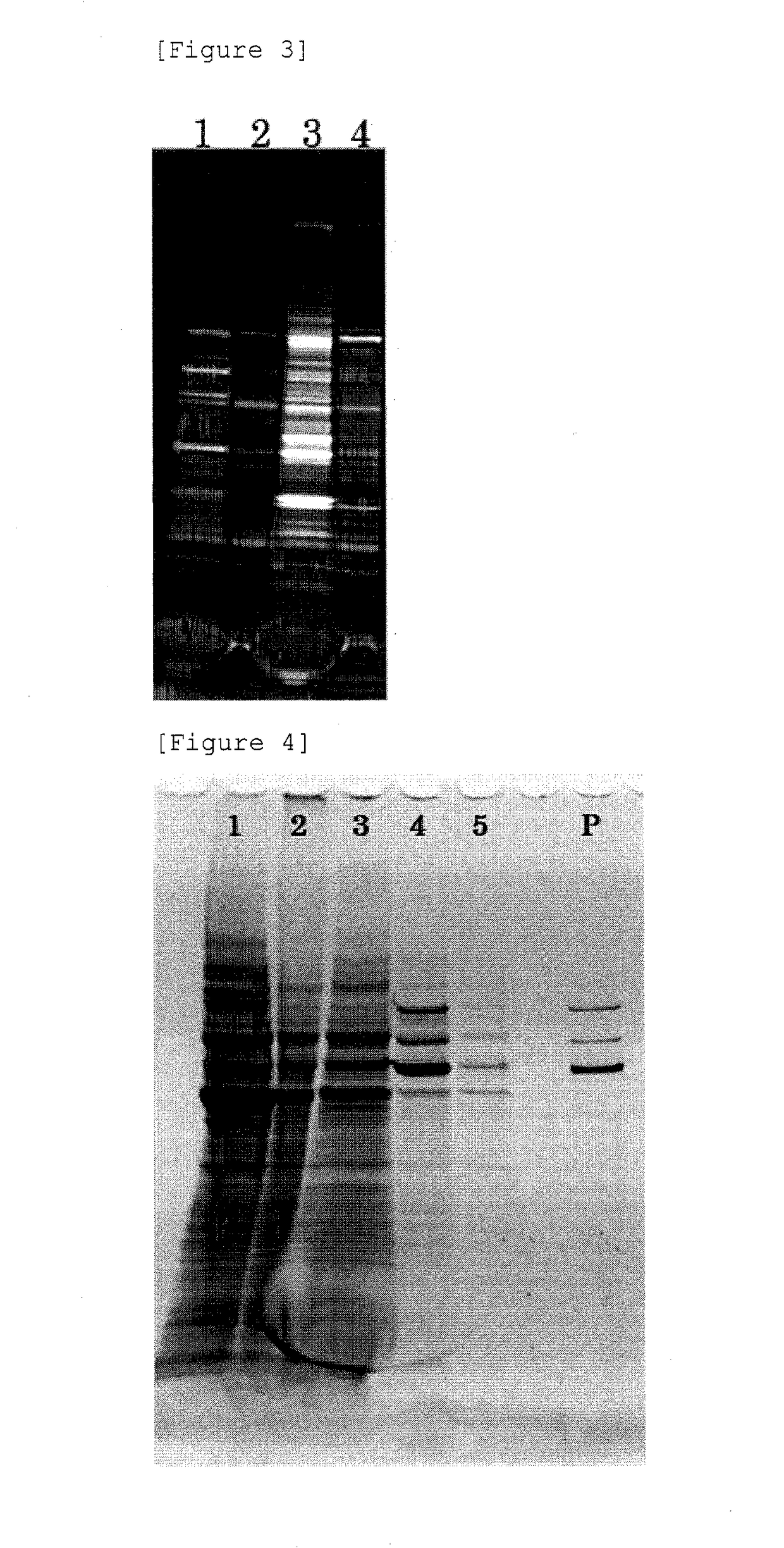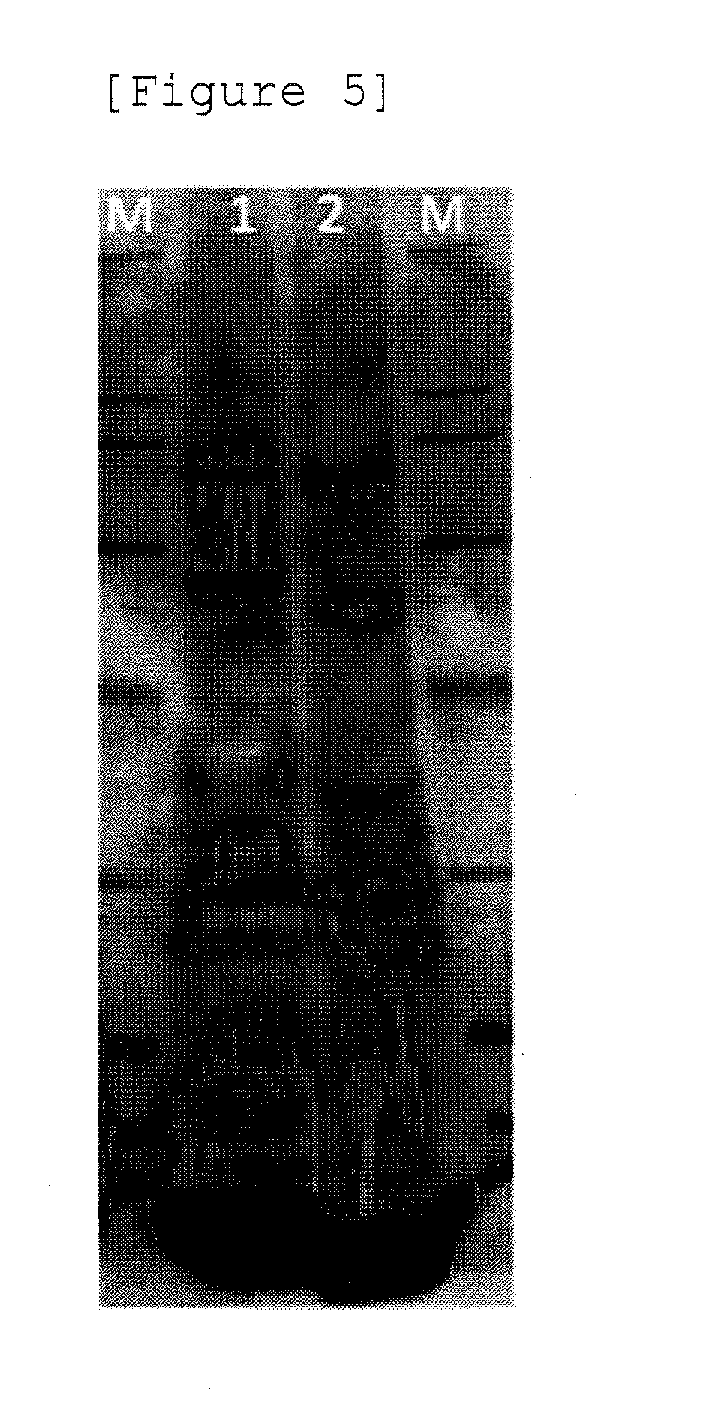Production method for non-enveloped virus particles
a production method and virus technology, applied in the field of non-enveloped virus particles, can solve the problems of inadequate purification methods, and achieve the effect of no laborious operation and high purity
- Summary
- Abstract
- Description
- Claims
- Application Information
AI Technical Summary
Benefits of technology
Problems solved by technology
Method used
Image
Examples
example 1
tion of PEG Concentration for Precipitation
[0054](1) Seeding of Cell for Production of rAAV Particle
[0055]In DMEM (manufactured by Sigma-Aldrich Co. LLC.) containing 10% FBS (manufactured by Hyclone Laboratories), 293T / 17 cells were suspended. The suspension was seeded in a CellBIND (registered trademark) T225 flask (manufactured by Corning Inc.), and then, cultured in a CO2 incubator at 37° C. for 3 days. The cells were confirmed to be about 70% confluent.
(2) Transfection of Plasmid for Production of rAAV Particle
[0056]The cells obtained by Example 1-(1) were transfected with each 25 μg of a pRC plasmid containing sequences encoding the Rep protein and the Cap protein of AAV type 2 (hereinafter, referred to as AAV2) (manufactured by Cell Biolabs, Inc.), a pHLP plasmid containing sequences encoding adenovirus-derived E2A, VA and V4 (manufactured by Cell Biolabs, Inc.), and a pAAV-AsRed2 plasmid containing “a CMV promoter sequence, a sequence encoding AsRed2, and a PolyA sequence” as...
example 2
f Impurity by PEG Precipitation Operation
(1) Preparation of Crude Extract by Citrate Buffer Treatment
[0063]A crude extract was prepared in the same manner as Example 1-(1) to (3). To the crude extract, 1 / 100 volume of 1 M MgCl2 was added, followed by treatment with BENZONASE at 37° C. for 1 hour.
(2) PEG Precipitation, Washing, and Concentration by 100K UF
[0064]The BENZONASE-treated crude extract obtained by Example 2-(1) was subjected to any one of the following treatment A to F to prepare a sample.
[0065]A: To the BENZONASE-treated crude extract, a 60% PEG-8000 solution was added so that the final concentration of PEG became 8%, mixed, and left standing on ice for 30 minutes. Then, the mixture was centrifuged at 1,500×g, at 4° C., for 30 minutes to collect a pellet. The pellet was suspended in PBS (manufactured by Gibco), and left standing overnight at 4° C. to dissolve the pellet. Thus sample A was prepared.
[0066]B: A pellet was obtained in the same manner as A. The pellet was rins...
example 3
f Impurity by Combination of PEG Precipitation Operation and Chloroform Treatment
(1) Preparation of Crude Extract by Citrate Buffer Treatment
[0075]A crude extract was prepared in the same manner as Example 1-(1) to (3). To the crude extract, 1 / 100 volume of 1 M MgCl2 was added, followed by treatment with BENZONASE at 37° C. for 1 hour.
(2) PEG Precipitation, and Chloroform Treatment
[0076]The BENZONASE-treated crude extract obtained by Example 3-(1) was subjected to any one of the following treatment G to J to prepare a sample.
[0077]G: To the BENZONASE-treated crude extract, an equal amount of chloroform (99% purity) was added, mixed by a vortex mixer for 10 seconds, and then centrifuged at 14,000×g, at 4° C., for 10 minutes to collect a supernatant (these operations are referred to as “the chloroform treatment”). To the supernatant, a 60% PEG-8000 solution was added so that the final concentration of PEG became 1%, mixed, and left standing on ice for 30 minutes. Then, the mixture was...
PUM
 Login to View More
Login to View More Abstract
Description
Claims
Application Information
 Login to View More
Login to View More - R&D
- Intellectual Property
- Life Sciences
- Materials
- Tech Scout
- Unparalleled Data Quality
- Higher Quality Content
- 60% Fewer Hallucinations
Browse by: Latest US Patents, China's latest patents, Technical Efficacy Thesaurus, Application Domain, Technology Topic, Popular Technical Reports.
© 2025 PatSnap. All rights reserved.Legal|Privacy policy|Modern Slavery Act Transparency Statement|Sitemap|About US| Contact US: help@patsnap.com



